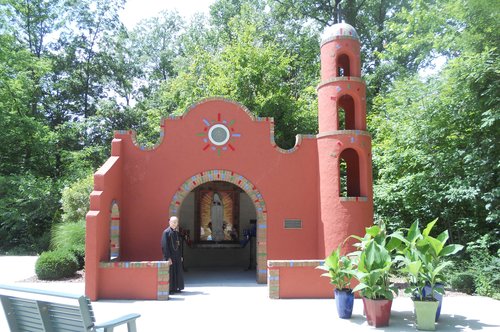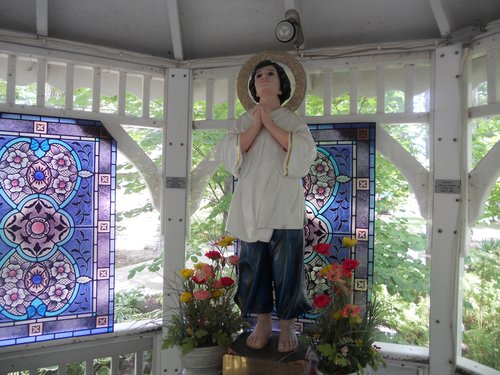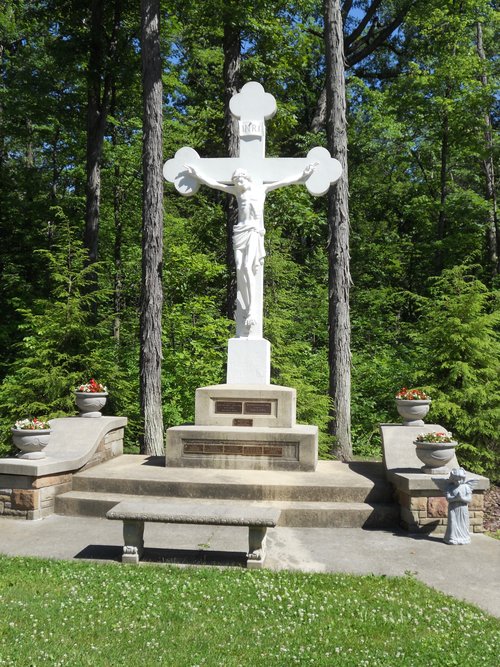Sorrowful Mother Shrine Celebrates St. Teresa
This weekend the Ohio site will honor the Church’s newest saint at a prayerful place highlighting many other holy lives.

Tucked into the woods of Sorrowful Mother Shrine in Bellevue, Ohio, stands a statue of Mother Teresa of Calcutta. On Sept. 10, the shrine will celebrate the newest saint with a procession and official dedication and blessing of the grotto by Father Scott Kramer, a priest of the Missionaries of the Precious Blood and the shrine’s director.
Sharon Ruffing began work on the grotto in 2007. Like many Catholics who built shrines or grottos on the 120-acre property, she intended it to be a lasting memorial to loved ones: her parents, Irene and Leonard Stockmeister.
Together, Ruffing and her mother watched Mother Teresa’s televised funeral in 1997. Ruffing admired the saint’s work with tuberculosis and leprosy patients, without fear of being exposed to the illnesses.
“She probably didn’t even have any rubber gloves,” Ruffing said, “but she took care of them the very best she could, and she showed all that love.”
Once Ruffing resolved to build the grotto, her husband, Terry, excavated the site and prepared the statue’s base and the walkway leading to it. The Ruffings’ children and Sharon’s sister and brother-in-law helped pour concrete and create a garden with shade-tolerant plants like hostas and Little Henry shrubs. Relatives from both the Ruffing and Stockmeister families contributed money for the project.
Ruffing imported an Italian statue of Mother Teresa holding a little child that details the saint’s facial features and clothing.
This summer, Terry Ruffing was admiring the completed grotto when he realized the path and the pad holding the statue form the shape of a chalice. On the ground behind the statue, he then installed a “host” made of hard plastic.
St. Teresa’s grotto figures among dozens of tributes to holy men and women erected on the site since Father Francis de Sales Brunner of the Missionaries of the Precious Blood founded Sorrowful Mother Shrine in 1850.
The faithful can go to confession and attend daily Mass year-round in the red-brick Sorrowful Mother Chapel built in 1913.
“Who is in the center [here]? Jesus in the tabernacle,” said Father Harry Brown, also of the Missionaries of the Precious Blood.

A shrine staff member for seven years, Father Brown is a Marriage Encounter team priest and a former seminary teacher. He happily pointed out the chapel’s treasures: Six of the Seven Sorrows of the Blessed Mother decorate the ceiling, painted on canvas by the late Father Paulinus Trost of the Missionaries of the Precious Blood. A statue of Mary cradling the broken body of her Son poignantly portrays the seventh sorrow.
Stained-glass windows on one side of the chapel focus on the Savior. In one window, he appears as “Jesus, Father of the Poor.” In another, fear ravages St. Peter’s face in a dramatic illustration of Christ calming the waters.
Windows on the opposite wall depict the Blessed Mother’s life or Marian apparitions. In one scene, for example, Mary hands St. Jerome Emiliani prison keys, enabling him to escape from jail. The Italian saint was captured as a soldier in 1511. After praying to Our Lady, he was freed through an apparition of her.
Near the altar hang crutches discarded by persons who believed they found cures at the shrine. Although staff do not ask people to report cures, word sometimes leaks out. In 2011, a man from Detroit left more than 20 pill bottles in the chapel before the Blessed Sacrament: He said he didn’t need them after his previous visit to the shrine.
To seat as many as 700 people at Mass during the warm months, the shrine added the outdoor Pietà Chapel in 1969. At least 12 ethnic groups use it during annual pilgrimages.
After visiting the chapel, pilgrims follow several winding walkways to small shrines, grottos and illuminated Stations of the Cross. At the edge of the forest, Father Brown praised a small structure composed of glass panels he called “teaching windows.” Painted in vibrant reds and blues, they relate to the Annunciation, St. Peter receiving keys from Jesus and other events important to our faith.
A group from Dayton, Ohio, raised this “mini shrine” in memory of Father Frederick Falce, another priest of the Missionaries of the Precious Blood. The former shrine director was robbed and murdered in Mexico in 1987.
Elsewhere, in an open, sun-drenched area, a granite memorial preserves the names and faces of 20th-century martyrs of the Ukraine. Pope John Paul II beatified these followers of the Eastern rite in 2001.
Some very old shrines to St. Francis of Assisi and other saints are fastened to trees. Providentially, when a violent storm toppled more than 100 trees on the property in 2013, none damaged a grotto, shrine or statue.

A colorful miniature church dedicated to Our Lady of Guadalupe faces a wide plaza. Nearby, an enormous crucifix casts a long shadow. It was erected shortly after World War I in memory of that conflict’s victims.
Franciscan Sister Bonnie Smith has welcomed pilgrims to the shrine and prayed with them as a volunteer for two years.
“Walking with people through the woods, I stress that it’s a pilgrimage,” she said. “It’s a way of coming to holiness, a way to experience God working in our lives through the saints and Jesus and Mary.”
In the beautiful outdoor setting, visitors feel the presence of God that enables spiritual healing. A group of World War II, Korea and Vietnam veterans prayed for peace with Sister Bonnie at the shrine to Our Lady of Fatima. Another time, a woman told the Franciscan that, during her visit, she finally forgave her husband for abandoning her.
“People feel such peace here,” Sister Bonnie said.
She was also touched by a pilgrimage of Chaldean Catholics, some of whom recently fled the Middle East because of persecution.
“It’s their faith that carries them,” Sister Bonnie said. “One gentleman said to me, ‘All I have is Jesus and Mary. And that is enough.’”

PLANNING YOUR VISIT
- A ministry of the Missionaries of the Precious Blood, Sorrowful Mother Shrine is open year-round from dawn to dusk.
- The shrine depends on donations for its existence.
- Located in the countryside of northwest Ohio, the shrine is accessible by the Ohio turnpike and major highways. For GPS directions, use address 4106 OH 269, Bellevue, Ohio. Mailing address is 4106 S.R. 269, Bellevue, OH 44811-9793.
- The Sorrowful Mother Chapel is a holy door in the Diocese of Toledo during this Year of Mercy. Pilgrims can borrow booklets from the chapel with prayers for each shrine or grotto on the grounds.
- More than a mile of paved surfaces make most of this outdoor shrine wheelchair-friendly. There are also some narrow, unpaved paths. Bring insect repellent. The replica of the Lourdes Grotto, the Mother Teresa Grotto and other spots provide benches where visitors can pray or rest.
- Groups often hold days of recollection at the shrine. For information call (419) 483-3435. The website is: http://sorrowfulmothershrine.org/.
- Meals in the cafeteria for groups of 15 or more persons can be arranged with advance notice. There are also picnic areas.
- The shrine gift shop offers an extensive selection of exclusively religious items.

















